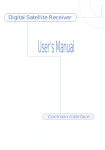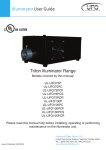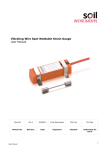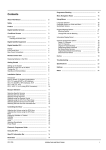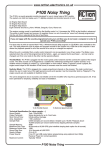Download Vivanco AV TRANSMITTERRECEIVER SET WITH IR FEEDBACK CHANNEL User guide
Transcript
5.8GHz Wireless AV Sender System 27998R USER GUIDE Philex Customer Careline 08457 573479 Introduction Congratulations on your purchase of the SLx 5.8GHz Wireless AV Sender System. This product has been designed to allow an audio/video signal from equipment such as DVD players, Digital TV receivers, Satellite Receivers and VCRs to be both watched and controlled in a different room without the need for runs of cable or DIY! The receiver can work within 30 metres of the Transmitter depending on the building structure and is supplied with an Infra-Red Extender & an Infra-Red Receiver allowing you to control your equipment from a different room. In this day and age, more and more equipment is becoming wireless. To prevent interference from neighbouring AV senders, wireless routers, DECT phones etc this system works transmitts on the 5.8GHz frequency which makes the system is not affected by interference from standard wireless equipment. There are also 3 operating channels to choose from allowing you to select the channel with the least interference. Before attempting to install the system, please read through the instructions carefully ensuring you understand the procedure and have all items necessary. Sender system components NOTE: The transmitter and receiver can be identified by the label on the base. TRANSMITTER RECEIVER WIRELESS TRANSMITTER CABLE WIRELESS RECEIVER CABLE INFRA-RED EXTENDER INFRA-RED RECEIVER POWER ADAPTORS x2 Page 1 Transmitter connections & switches layout 5.8GHz ANTENNA POWER LED ON/OFF SWITCH FRONT PO W ER INFRA-RED EYE EXTENDER SOCKET F OF ON IR-T BACK POWER LED PO ER W AV INPUT SOCKET AV IN DC 7.5 V DC INPUT CH AN NE L AN T CHANNEL SELECT BUTTON 5.8GHz ANTENNA NOTE: Transmitter can be identified by label under the unit Page 2 Receiver connections & switches layout 5.8GHz ANTENNA POWER LED ON/OFF SWITCH FRONT PO W ER INFRA-RED RECEIVER SOCKET F OF ON IR-R BACK POWER LED PO ER W AV OUTPUT SOCKET AV O UT DC INPUT DC 7.5 V CH AN NE L AN T CHANNEL SELECT BUTTON 5.8GHz ANTENNA NOTE: Receiver can be identified by label under the unit Page 3 Getting the best reception and saving energy • Both the AV Transmitter and Receiver units should be placed on flat, stable surfaces. • Minimise the number of obstacles between the AV Transmitter and Receiver. • Rotate the 5.8GHz Antenna on the Transmitter and Receiver so they are standing up at 90 degrees. • For energy saving purposes please switch off all your AV equipment when not in use, including the 5.8GHz AV Sender. Setting up your Transmitter and Receiver CONNECTING THE RECEIVER (Connects to 2nd TV (e.g. in Bedroom or Kitchen) 1) Plug the 3.5mm Jack end of the ‘Wireless Receiver Cable’ into the AV OUT socket on the Receiver. Ensure that the 3.5mm JACK is plugged all the way into the AV OUT socket. CONNECTING THE TRANSMITTER (Main viewing room, e.g. Sitting Room) 2)Plug the Scart end of the ‘Wireless Receiver Cable’ into the Scart input on the television located in the receiving room - (See Fig. 2) 6) Plug the Scart end of the ‘Wireless Transmitter Cable’ into the Scart output socket on your AV source equipment (satellite receiver, VCR or DVD). 3) Connect one of the power adaptors to the DC input on the Receiver as shown in Fig. 2. Plug the power adaptor into a mains socket and switch the socket ON, the Power LED should come on. If the LED does not light up, ensure that the ON/OFF switch on the Receiver is set to ON. 7) Plug the Infra-Red Extender cable into the Infra Red Socket on the Transmitter as shown in Fig. 3. INFRA-RED RECEIVER 4) Position the INFRA-RED RECEIVER on top/in front of your television or any other location in direct line of sight with your remote controls (See Fig.1). Use the adhesive pad supplied to hold it in place when you are happy with the position. Fig. 1 -Positioning the Infra-Red Receiver Infra-Red Receiver Note: Attach with supplied Sticky-Back Velcro Pad 5) 8) Plug the 3.5mm Jack end of the ‘Wireless Transmitter Cable’ into the AV IN socket on the Transmitter. Ensure that the 3.5mm Jack is plugged all the way in to the AV IN socket. Position one of the Infra-Red Eyes on the Infra- Red Extender lead in front of the infra-red sensor window of your AV source equipment (satellite receiver or VCR or DVD). The infra-red sensor window on some satellite receivers is marked by this symbol . Make sure the curved surface of the Infra-Red Eye is facing the sensor window as shown in Fig. 4 and (For further tips on locating the Infra-Red sensor window see Troubleshooting section). 9) Connect the remaining power adaptor to the DC input on the Transmitter as shown in Fig. 3. Plug the power adaptor into a mains socket and switch the socket ON, the Power LED shall now be lit. If the LED does not light up, ensure that the ON/OFF switch on the Transmitter is set to ON. 10) On the back of both the Transmitter and Receiver are 3 channel switches. Ensure that the same channel switch on both the Transmitter and Receiver are set to the same number. 11)Select an appropriate AV channel on the receiving television. The television should now show whatever signal the Transmitter is sending and if the infra red eye is properly positioned you will be able to control the AV source by pointing the correct remote control at the AV Receiver. Page 4 Fig. 2 - Receiver Connections Room 2 SECOND TV (BEDROOM/KITCHEN etc.) RECEIVER UNIT INFRA-RED RECEIVER POWER ADAPTOR SCART INPUT AV IN DC 7.5V CHANNEL ANT WIRELESS RECEIVER CABLE Fig. 3 -Transmitter Connections Main Room TRANSMITTER UNIT INFRA-RED EXTENDER (see Fig. 3 for positioning) SAT, DVD, DVBT etc POWER ADAPTOR SCART OUTPUT AV IN DC 7.5V CHANNEL ANT WIRELESS TRANSMITTER CABLE Fig. 4 -Positioning the Infra Red Eye SATELLITE Infra red eyes Make sure the curved surface of the infra red eye is facing the sensor window Page 5 Troubleshooting Problem Cause PROBLEM CAUSE No Picture or Sound The Transmitter and receiver are set to different channels The Transmitter and/or Receiver are not powered The Transmitter and/or Receiver Leads are incorrectly fitted/reversed Transmitter and/or Receiver Units are reversed The equipment providing or receiving the AV signal are incorrectly setup Distance between the Transmitter and receiver is too far Black and White The equipment providing or (Monochrome receiving the AV signal are Picture) set to RGB, Component Video, SVHS S Video, DVI or HDMI Poor Picture Quality Interference from microwaves ovens. Obstruction to signal Distance between the Transmitter and receiver is too far The Transmitter and receiver are set to different channels The equipment providing or receiving the AV signal are incorrectly set Page 6 Action ACTION Set to identical channels (See step 10) Check the power switch on the unit(s) are in the On position Check that the Mains Electrical power is switched on Check the Mains adaptors are fitted correctly (See Steps 3 & 9) Swap over both leads so the correct leads are used with the Receiver/Transmitter The leads are not inserted correctly, ensure that the scart plug has no bent pins and it making contact with the scart socket Swap over the Transmitter and Receiver units Check that the Transmitting and Receiving Equipment are powered up and providing a Scart Input and output signal Ensure that correct Scart input has been selected on the Receiving equipment Set the Scart output/input to Composite Video (CVBS) (See Equipment Suppliers Manual for how to set) Reduce the distance between the units or position the units for a better signal Set the Scart output/input to Composite Video (CVBS) (See Equipment Suppliers Manual for how to set) Move Transmitter/Receiver away from microwave. Place away from walk ways or walk through areas Place away from Thick walls, masonry or metalwork Reduce the distance between the units or position the units for a better signal Set to identical channels (See step 10) The Leads are not inserted correctly, ensure that there are no bent pins in the scart plug and it making contact PROBLEM CAUSE ACTION All the available scart sockets are being used Equipment has insufficient scart sockets Infra red remote control does not function Infra-Red Eyes set up incorrectly Sunlight or high output lighting is blocking the Signal Incorrect Remote used Purchase an unswitched scart splitter for the transmitting equipment and/or a switched scart selector for the receiving equipment Connect equipment using other connector type e.g. Coax flylead Infra red transmitting and/or receiving eyes are not positioned correctly (See Step 8) Block the excessive light Infra red Transmitter or receiver signal is obstructed Difficulty finding the Infra red sensor on the Transmitting Equipment (DVD, Satellite etc) Intermittent or no Infra red operation Cable Box which use IRDA Remote controls Use Original or compatible Remote controls Remove obstruction and position the Infra red eyes for a better signal (See Figs 4 and 8) and use a second person aiming the remote control at the AV Receiver while the first person moves the Infra red eyes in front of the Transmitting Equipment Check that the Infra red leads are correctly inserted into the Infra red Socket(s) Check the remote works directly with the Transmitting equipment and that the batteries are not discharged Some cable boxes use an IRDA remote control system these will not work with you AV sender (Contact your Cable supplier to see if your box uses IRDA Page 7 For further information or any queries, please contact Philex Customer Careline: 08457 573 479 (Local rate – UK only) Technical Support: [email protected] 1856 Declaration of Conformity available at: http://technical.philex.com Waste electrical products should not be disposed of with household waste. Please recycle where facilities exist. Check with your Local .Authority for recycling advice Page 8 © Philex Electronic Ltd. 2008 v1.1








